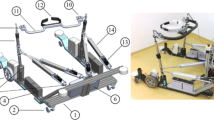Abstract
In order to deal with the problem of imbalance of the elderly in the process of walking on level ground, this paper proposes a hip exoskeleton with series elastic actuator (SEA) to assist the wearer to adjust the step width, step length and step frequency in real time during walking to maintain balance walking. Through the built multi-sensor fusion gait perturbation and perception integrated platform, the experimenter’s autonomous recovery of balance experiment and exoskeleton-assisted human body's recovery of balance experiment under external wrench state were carried out respectively. The perturbations were applied in four directions to the experimenter while walking, which verified the validity of the balance evaluation model and the assisting effect of the exoskeleton in restoring the balance of human walking. Firstly, according to the established kinematics model, the displacement and velocity of the experimenter's center of mass during walking are calculated, and the system is simplified to a linear inverted pendulum model (LIPM) to evaluate the motion state. Secondly, a balance state evaluation model is established based on the instantaneous capture point (ICP) theory, and the balance state evaluation of the human body is realized by judging the positional relationship between the instantaneous capture point and the support range of the feet. Finally, according to the step strategy in the human body balance strategy, the magnitude of the auxiliary torque when the experimenter is out of balance is calculated through the relative position of the center of mass and the instantaneous capture point. Therefore, it can be shown that the balance evaluation model and exoskeleton control strategy we established can provide the balance restoring torque for the experimenter to swing the leg when the system is about to become unbalanced, which can effectively slow down the unbalanced trend.
Access this chapter
Tax calculation will be finalised at checkout
Purchases are for personal use only
Similar content being viewed by others
References
Population Division of the Department of Economic and Social Affairs of the United Nations Secretariat. 2019 Revision of World Population Prospects (2019). https://population.un.org/wpp/
Zhou, M.G., Wang, H.D., Zeng, X.Y., et al.: Mortality, morbidity, and risk factors in China and its provinces, 1990–2017: a systematic analysis for the Global Burden of Disease Study 2017. Lancet 394(10204), 1145–1158 (2019)
Yasuhara, K., Shimada, K., Koyama, T., Ido, T., Kikuchi, K., Endo, Y.: Walking assist device with stride management system. Honda R&d Tech. Rev. 21, 54–62 (2009)
Monaco, V., et al.: An ecologically-controlled exoskeleton can improve balance recovery after slippage. Sci. Rep. 7, 46721 (2017)
Sanchez-Villamañan, M.D.C., Gonzalez-Vargas, J., Torricelli, D., et al.: Compliant lower limb exoskeletons: a comprehensive review on mechanical design principles. J. NeuroEng. Rehab. 16(1) (2019)
Winter, D.A.: Human balance and posture control during standing and walking. Gait Posture 3(4), 193–214 (1995)
Horak Fay, B., Nashner, L.M.: Central programming of postural movements: adaptation to altered support-surface configurations. J. Neurophysiol. 55(6), 1369–1381 (1986)
Pratt, J., Carff, J., Drakunov, S., et al.: Capture point: a step toward humanoid push recovery. In: 6th IEEE-RAS International Conference on Humanoid Robots (2007)
Young, A., Ferris, D.: State-of-the-art and future directions for robotic lower limb exoskeletons. IEEE Trans. Neural Syst. Rehab. Eng. 1 (2016)
Schiele, A.: Ergonomics of exoskeletons: objective performance metrics. In: 3rd Joint EuroHaptics Conference and Symposium on Haptic Interfaces for Virtual Environment and Teleoperator Systems, pp. 103–108 (2009)
Zhang, T., Tran, M., Huang, H.: Design and experimental verification of hip exoskeleton with balance capacities for walking assistance. IEEE/ASME Trans. Mechatron. 23(1), 274–285 (2018)
Arno, H.A.S., Hekman, E.E.G., et al.: Design of a rotational hydroelastic actuator for a powered exoskeleton for upper limb rehabilitation. IEEE Trans. Biomed. Eng. 57, 728–735 (2010)
Kashiri, N., Malzahn, J., Tsagarakis, N.G.: On the sensor design of torque controlled actuators: a comparison study of strain gauge and encoder based principles. IEEE Robot. Autom. Lett. 2, 1 (2017)
Tucker, M.R., Shirota, C., Lambercy, O., et al.: Design and characterization of an exoskeleton for perturbing the knee during gait. IEEE Trans. Biomed. Eng. 64(10), 2331–2343 (2017)
Acknowledgement
This work was supported in part by the National Key R&D Program of China (2020YFC2007804), the Natural Science Foundation of the Jiangsu Higher Education Institutions of China (19KJA180009), the Natural Science Foundation of Jiangsu Province (BK20191424), the Jiangsu Frontier Leading Technology Fundamental Research Project (BK20192004D), and the Distinguished Professor of Jiangsu province.
Author information
Authors and Affiliations
Corresponding author
Editor information
Editors and Affiliations
Rights and permissions
Copyright information
© 2022 The Author(s), under exclusive license to Springer Nature Switzerland AG
About this paper
Cite this paper
Feng, K., Zhang, T. (2022). A Perturbation Platform and Exoskeleton Simulator for Studying Balance Control of Hip Exoskeleton: Design and Preliminary Validation. In: Liu, H., et al. Intelligent Robotics and Applications. ICIRA 2022. Lecture Notes in Computer Science(), vol 13457. Springer, Cham. https://doi.org/10.1007/978-3-031-13835-5_11
Download citation
DOI: https://doi.org/10.1007/978-3-031-13835-5_11
Published:
Publisher Name: Springer, Cham
Print ISBN: 978-3-031-13834-8
Online ISBN: 978-3-031-13835-5
eBook Packages: Computer ScienceComputer Science (R0)



